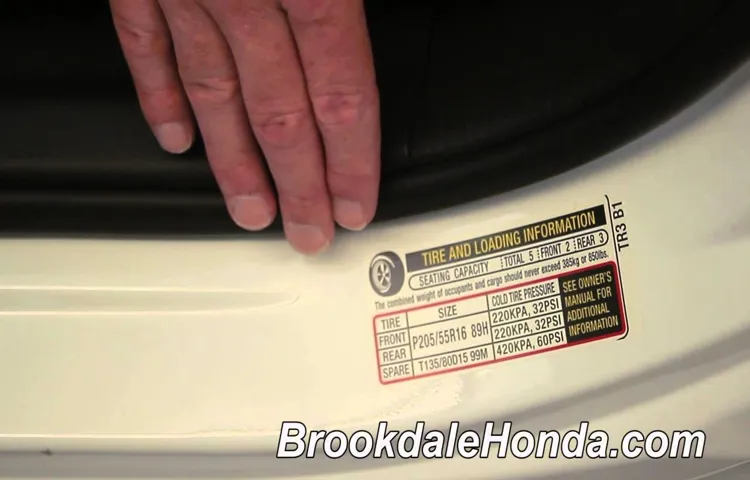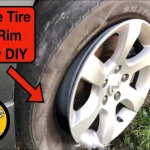With the hustle and bustle of everyday life, it’s easy to overlook the importance of proper tire pressure. But did you know that maintaining the correct tire pressure not only improves your car’s handling, but also maximizes fuel efficiency and extends the life of your tires? As a Honda Civic owner, it’s essential to stay on top of your tire pressure levels. In this guide, we’ll cover everything you need to know about Honda Civic tire pressure, including how to check it, what the recommended levels are, and why it matters.
Get ready to hit the road with confidence and safety!
Table of Contents
Why Proper Tire Pressure Matters
If you own a Honda Civic, it’s crucial to know the recommended tire pressure for your vehicle to ensure your safety and the longevity of your tires. The ideal tire pressure for a Honda Civic varies depending on the year and model of your car. Generally, the recommended pressure for a Honda Civic is between 32 to 35 PSI (pounds per square inch) for all four tires.
It’s important to check your tire pressure regularly, especially after changes in temperature or if you notice any signs of uneven wear or damage to your tires. Driving with improper tire pressure can lead to reduced fuel efficiency, decreased handling, and even accidents. By maintaining the correct tire pressure, you can improve your Civic’s performance, save money on fuel, and ensure a smooth ride every time.
Don’t forget to consult your owner’s manual or ask a professional mechanic if you’re unsure about the proper tire pressure for your Honda Civic.
Improve Safety and Handling
Proper tire pressure plays a significant role in keeping you and your passengers safe while on the road. Underinflated tires can lead to poor handling, increase the chances of a blowout, and even decrease fuel efficiency. On the other hand, overinflated tires can make the ride feel stiff and bumpy, shorten the lifespan of the tires, and reduce the overall gripping ability.
Maintaining the recommended tire pressure ensures optimal handling, steering response, and braking performance, making it crucial to incorporate regular checks as part of your vehicle maintenance routine. By keeping your tires inflated correctly, you can experience a smoother, safer ride and prolong the life of your tires. So next time you hit the road, take a moment to ensure that your tires are correctly inflated, and enjoy the peace of mind that comes with being in control of your vehicle.

Increase Fuel Efficiency
Proper tire pressure is crucial for increasing your vehicle’s fuel efficiency and reducing carbon emissions. When your tires are underinflated, they create more rolling resistance, causing your engine to work harder and burn more fuel. In fact, studies show that keeping your tires at the recommended pressure can improve your fuel efficiency by up to 3%.
Over time, those savings can add up to significant amounts of money and help the environment. Checking your tire pressure regularly is easy and inexpensive, and it’s a simple way to make sure you’re getting the most out of your vehicle. Remember, proper tire pressure not only keeps you safe but also benefits your wallet and the planet.
How to Find Your Honda Civic’s Recommended Tire Pressure
If you’re wondering about the tire pressure for a Honda Civic, you’ve come to the right place. The recommended tire pressure for a Honda Civic generally varies based on the model and year but can typically be found in the owner’s manual or on a sticker located on the driver’s side door jamb. It’s important to maintain the correct tire pressure as it can affect the safety, handling, and fuel efficiency of your vehicle.
Underinflated tires can cause premature wear, reduce fuel efficiency, and affect the vehicle’s stability. On the other hand, overinflated tires can lead to a bumpy ride, reduced traction, and uneven wear. It’s recommended to check your tire pressure at least once a month and before long road trips.
You can easily find a tire pressure gauge at most auto parts stores, and it only takes a few minutes to ensure that your tires are at the correct pressure. Keeping your Honda Civic’s tires correctly inflated will ensure a smoother, safer ride every time.
Check Your Owner’s Manual
As a Honda Civic owner, you should always consult your vehicle’s owner’s manual to find the recommended tire pressure. The ideal tire pressure varies based on the model of your car, the size of the tires, and driving conditions. The owner’s manual contains all of this information and can help you determine the appropriate tire pressure for your Honda Civic.
Maintaining proper tire pressure is crucial for your car’s safety, handling, and fuel efficiency. With the help of your owner’s manual, you can easily locate the recommended tire pressure for your Honda Civic and ensure that your tires are always inflated to the correct level. So, always remember to check your owner’s manual before inflating your car’s tires or making any adjustments to it.
It’s crucial to follow the manufacturer’s recommendations to ensure your safety while driving and to maximize the lifespan of your vehicle’s tires.
Check Your Tire Sidewall Information
One important aspect of maintaining proper tire pressure for your Honda Civic is to check the tire sidewall information. This information can provide useful insights into the recommended tire pressure for your vehicle. First, locate the tire size on the sidewall of your tire.
It will typically be a series of numbers and letters, such as “205/60R16”. This represents the width of the tire, its aspect ratio, and the diameter of the wheel. Next, reference your owner’s manual or the tire placard located on the inside of the driver’s side door jamb.
This will provide you with the recommended tire pressure for your specific vehicle. Keep in mind that the recommended tire pressure may differ depending on the size of your tires or if you have added additional weight to your vehicle. Always check your tire pressure regularly and adjust accordingly to ensure optimal performance and safety on the road.
Recommended Honda Civic Tire Pressure
When it comes to maintaining your Honda Civic, proper tire pressure is essential. The recommended tire pressure for a Honda Civic can vary depending on the year and model, but generally, it falls between 32 to 35 PSI (pounds per square inch). To find the exact tire pressure for your specific Civic, you can refer to the owner’s manual or the sticker inside the driver’s side door jamb.
It’s important to check tire pressure regularly and make adjustments as needed, especially during temperature fluctuations. Keep in mind that over-inflated or under-inflated tires can cause uneven wear and affect your car’s handling and fuel economy. Maintaining proper tire pressure will not only extend the life of your tires but also ensure a safer and smoother ride.
So, take a few minutes to check your Honda Civic’s tire pressure regularly and enjoy the benefits of a well-maintained vehicle.
Standard Trim Levels: 32 psi
If you’re a proud owner of a Honda Civic, it’s essential to keep an eye on your tire pressure. Maintaining the recommended Honda Civic tire pressure ensures a smooth and safe driving experience. The standard trim levels of this car call for a tire pressure of 32 psi, but it’s always wise to check the owner’s manual for the correct tire pressure for your vehicle.
Proper tire pressure improves your car’s fuel economy, extends the life of your tires, and ensures your car’s stability and handling. It’s also important to note that the amount of air pressure needed might vary based on the type of tires you have or the season. Failing to maintain the proper tire pressure can lead to uneven tire wear, reduced traction, or even tire failure.
Make a habit of checking your tire pressure monthly and before long trips to ensure optimal performance and safety. Remember, your Honda Civic’s tire pressure is a small detail that can have a significant impact on your driving experience.
Sport Trim Levels: 35 psi
When it comes to your Honda Civic tire pressure, it’s essential to ensure you have the correct pressure level for your specific model and trim level. If you have a Sport trim level, the recommended tire pressure is 35 psi. It’s crucial to follow this recommendation to ensure your vehicle performs optimally and stays safe on the road.
Maintaining the correct tire pressure level can also improve your car’s fuel efficiency and prolong the lifespan of your tires. Additionally, it’s always wise to check your tire pressure regularly, especially before long trips, to avoid any potential issues. So, next time you’re driving your Honda Civic Sport, make sure your tire pressure is set to 35 psi for the smoothest and safest experience.
Touring Trim Levels: 33 psi
When it comes to maintaining your Honda Civic, tire pressure is an essential factor that should not be overlooked. The recommended tire pressure for a Honda Civic varies depending on the trim level and tire size. For instance, the touring trim level of a Honda Civic has a recommended tire pressure of 33 psi.
Maintaining the correct tire pressure is crucial for your vehicle’s overall performance, including handling, fuel efficiency, and even tire wear. Keeping your tires inflated to the correct pressure will ensure that your Civic rides smoothly and handles corners with ease. Moreover, having the right pressure in your tires will also contribute to your vehicle’s fuel efficiency, helping you get the most out of your fuel tank.
Proper tire inflation also helps prevent uneven tire wear, which can ultimately lead to costly repairs. So, make sure to check your Civic’s tire pressure regularly, and top them off when needed, based on the specific trim level and tire size.
Maintaining Proper Tire Pressure
If you own a Honda Civic, it’s important to maintain proper tire pressure to ensure a safe and efficient driving experience. According to Honda, the recommended tire pressure for most Honda Civic models is around 32 psi (pounds per square inch). However, it’s important to check your vehicle’s owner manual or the sticker on the driver’s side door jamb to verify the appropriate tire pressure for your specific make and model.
It’s important to keep in mind that tire pressure can fluctuate due to factors such as temperature changes and natural depletion over time. It’s recommended to check your tire pressure on a regular basis, at least once a month, and especially before long road trips. Maintaining proper tire pressure not only increases safety but also can improve fuel efficiency and prolong the lifespan of your tires.
So, it’s a small task that can have big benefits in the long run.
Check Pressure Monthly
Maintaining proper tire pressure is crucial to not only extend the lifespan of your tires but also to ensure a safe and comfortable driving experience. One simple way to keep your tires properly inflated is by checking the pressure monthly. The recommended tire pressure for your vehicle can be found in your owner’s manual or on a sticker located in the driver’s side door jamb.
Using a tire pressure gauge, check the pressure of each tire and add air as needed. It’s important to note that tire pressure can fluctuate due to temperature changes, so it’s best to check it when the tires are cold. Proper tire pressure can improve fuel efficiency, prevent uneven wear, and optimize handling and braking performance.
Don’t underestimate the importance of maintaining proper tire pressure – make it a habit to check it monthly.
Use a Quality Tire Gauge
Maintaining proper tire pressure is crucial to keep your vehicle in top condition. Using a quality tire gauge is essential to ensure accuracy in measuring tire pressure. It can be tempting just to eyeball the tire pressure or rely on the indicator light in your car, but these methods are often unreliable.
A quality tire gauge is necessary to provide accurate readings and avoid under or overinflating your tires. It’s a small investment that can save you money in the long run by improving fuel efficiency and reducing wear and tear on the tires. So, make sure to invest in a quality tire gauge and check your tire pressure regularly.
Your car will thank you for it!
Inflate or Deflate as Needed
Maintaining proper tire pressure is an essential aspect of car maintenance that is often overlooked by vehicle owners. It may seem like a minor issue, but keeping your tires inflated to the correct pressure can greatly enhance your driving experience and even increase your gas mileage. When your tires are underinflated, they have more rolling resistance, which requires more energy from your engine to move your vehicle, ultimately causing your gas mileage to suffer.
Conversely, overinflated tires may cause your vehicle to become unstable, leading to poor handling on the road and potential blowouts. By keeping your tires at the manufacturer-recommended pressure levels, you’ll improve your vehicle’s performance, make your car safer, and save yourself some money on fuel. So, next time you’re at the gas station, take a few minutes to check your tire pressure and inflate or deflate as needed.
Final Thoughts and Reminders
When it comes to maintaining your Honda Civic, one important thing to keep in mind is the tire pressure. The recommended tire pressure for a Honda Civic can vary depending on the year and model, so it’s important to consult your owner’s manual or do a quick search online to find the appropriate pressure for your specific vehicle. Generally speaking, the recommended tire pressure for a Honda Civic ranges from 32 to 36 PSI (pounds per square inch).
Proper tire pressure not only helps to extend the life of your tires, but it can also improve fuel efficiency and overall vehicle handling. So, take a few minutes to check your tire pressure regularly and be sure to fill them to the recommended level for a safe and comfortable ride.
Conclusion
In conclusion, the tire pressure for a Honda Civic is not just a number to be plugged into your tires. It’s a delicate balance between safety, performance, and efficiency. It’s the difference between a smooth ride and a bumpy one, between optimal gas mileage and wastefulness, and between a tire blowout and a safe journey.
So, next time you’re checking your tire pressure, don’t just think of it as a chore – think of it as a small but important step towards a better driving experience.”
FAQs
What is the recommended tire pressure for a Honda Civic?
The recommended tire pressure for a Honda Civic is typically 32 psi for front and rear tires.
Does the tire pressure vary based on the year of the Honda Civic?
The recommended tire pressure may vary slightly based on the year of the Honda Civic, so it’s best to consult your owner’s manual for the specific recommended pressure.
Can overinflating or underinflating tires affect the performance of a Honda Civic?
Yes, overinflating or underinflating tires can affect the handling, fuel economy, and overall performance of a Honda Civic, so it’s important to maintain the recommended tire pressure.
How often should the tire pressure be checked on a Honda Civic?
Tire pressure should be checked at least once a month on a Honda Civic, and before any long road trips.
What is the consequence of driving with low tire pressure on a Honda Civic?
Low tire pressure can cause poor fuel economy, decreased handling and braking abilities, and increased risk of a blowout or accident on a Honda Civic.
How can I check the tire pressure on my Honda Civic?
Tire pressure can be checked using a tire pressure gauge on the valve stem of each tire of a Honda Civic.
Can a Honda Civic’s tire pressure monitoring system (TPMS) notify me of low tire pressure?
Yes, many Honda Civics come equipped with TPMS, which will alert the driver if tire pressure is low. However, it’s still important to manually check tire pressure regularly.



